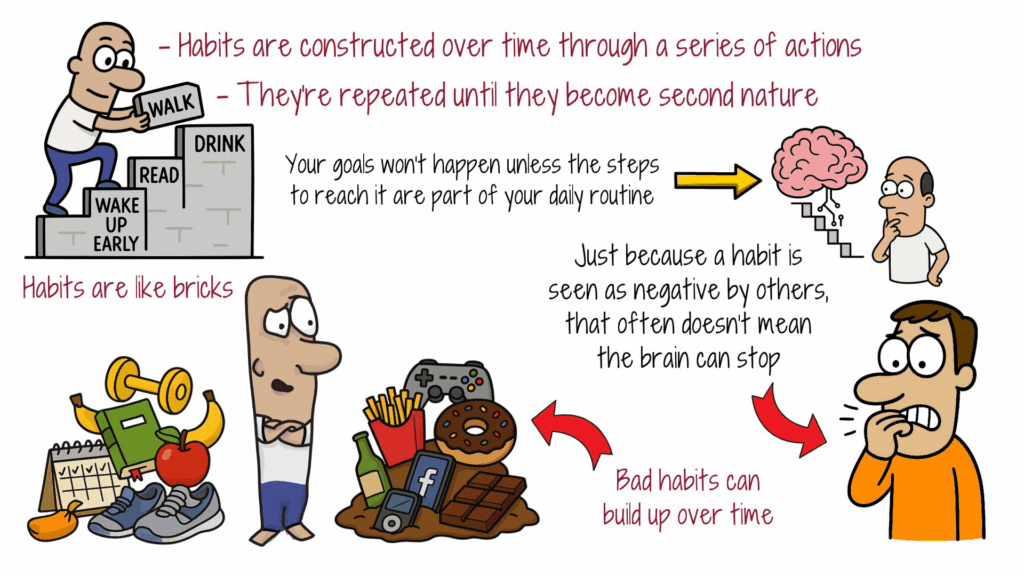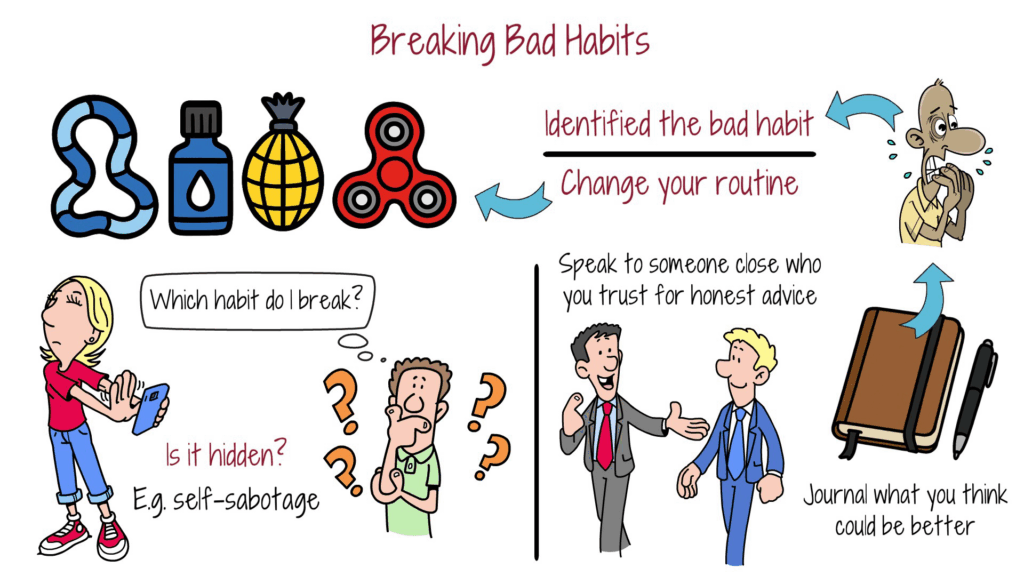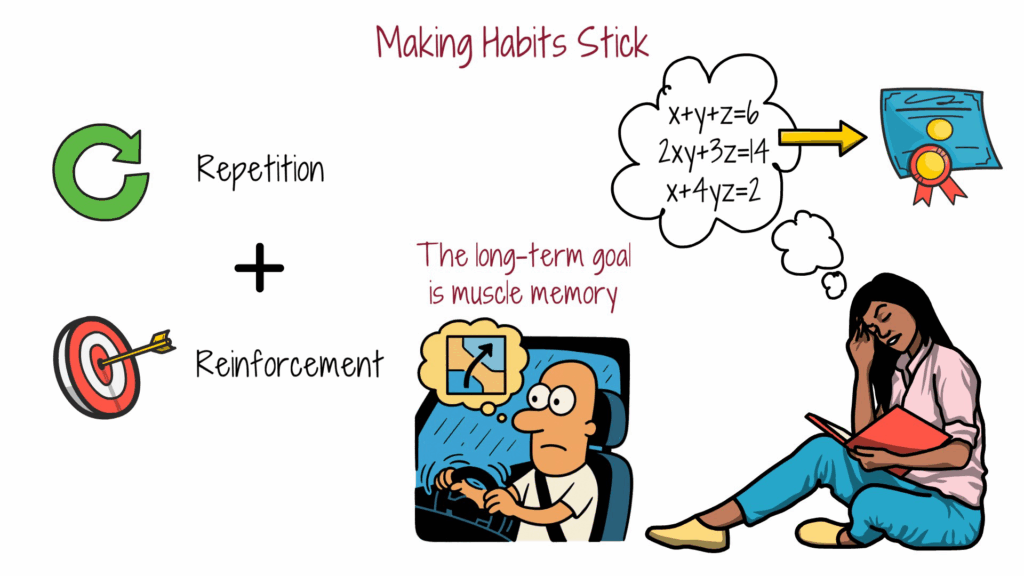Imagine this scenario. You’ve just moved house, and for the first time, you’re doing a weekly shop. The route is almost the same – you haven’t moved far in this scenario – but with slight differences. You buy your food and head home. As you drive home, you realise you’re not driving home, you’re driving to your old place. The route shares some similarities. You feel a little silly. Chances are you say to yourself:
Force of habit.
That age-old saying has, well, become a habit for most people. Your brain and body will latch on to routine systems, experiences, and processes in the form of habits, whether you like it or not. Your brain craves routine, so when you provide it with repeated actions, you’ll find yourself latching on – even if you know it might be bad for you.
That’s the thing with habits, they aren’t all necessarily good. Habits might take the form of biting fingernails – just because it’s seen as negative by others, that often doesn’t mean the brain can stop. What’s more, they build up over time. One thing people often do wrong when trying to build better habits is precisely that – they don’t build. Habits – good and bad – are constructed over time through a series of actions. They’re repeated until they become second nature.
This is precisely why building habits can prove difficult. You may have lofty expectations for yourself this year, but they won’t come to fruition unless the means you require to reach that point are built into your own internal software.
Think of habits like bricks – one after another, brick by brick, each as important as the last.

As previously explained, the more often you take the new route to the shops, the more habitual it will become. Your brain will reroute, breaking old habits and forming new ones. If we were to take this principle and apply it in a wider context – to build better, healthier habits – a similar framework would apply.
Let’s say you want to make exercise a part of your routine but struggle to build momentum. You can work out once or twice a week but when it comes to compounding that initial work, you struggle. You feel you’ve tried everything – trying radical new forms of exercise, hiring a personal trainer, or even purchasing a fitness course. Nothing seems to be working, however. This is because habits are not built in a week. There’s no definitive time frame, but one thing is certain: habits are made through small, repeated actions. Here, you could start by setting yourself a goal of one weekly session with a few walks littered throughout the week. This easy target provides you with the fuel that is vital in building habits – a sense of achievement.
The further you feel you’re getting, the easier it will be to build habits. That feeling must be sought throughout the process.
Building New Habits
Habits come in all shapes and sizes. You’ll find them littered throughout your daily life. More than that, they are the driving force of your daily actions which, over time, form your internal framework. Their importance is built up over extended periods because they can take considerable time to come to fruition. Think of habits as the building blocks in your ongoing construction.

Given habits take some time to form, building new ones can prove especially daunting. Think about how many healthy, productive goals you’ve set and subsequently not hit. They’re all well-intentioned, but they don’t have habits in mind. You cannot expect to reach all of your targets if you don’t work on the habits that will get you there first.
With habits, you must slow down and use the smaller picture to help build the bigger one. If you love a metaphor, think of habits as pieces to a puzzle. Individually, they are scattered and don’t resemble anything. Put together and ordered, however, and they resemble the art you bought the puzzle for – the literal bigger picture. Piece by piece, habit by habit.
In literal terms, habits are put into action through small, repeated actions. Again, let’s use the popular example of fitness. In this scenario, you know you should be working out more. You’ve built consistency before but, in the time since, lots of change has happened, interrupting your momentum and steering you off track. Amongst a swathe of motivation, you think a new form of exercise will help solve your problems. For example, you used to lift weights but now you want to swim. In this pursuit of more fitness, you set a goal of swimming 3 times a week.
By week 2, you’ve not hit your target. The resulting disappointment is difficult to take and it feels like you’re back at square one. Any momentum has dived.
The problem here is that you cannot hope to hit any goal if you don’t align with the habit-building process. In this instance, a more sustainable method would be to go swimming once a week for a while, before gradually increasing to 2 or 3 times once you feel comfortable.
You can’t force habits. They need to be natural.
Breaking Bad Habits
Knowing which of your bad habits to break is perhaps the simplest form of habit work – on the surface level, at least. Despite this, habits can often be so ingrained into us that they are hidden. Bad habits don’t just have to be things like biting your fingernails, they can come in the form of self-sabotage in relationships, for example. Whatever it is, you can’t improve yourself if you don’t know what to fix.

So that’s the first step. In terms of practice, consider speaking to someone close to you whom you trust for some honest advice on what they think your bad habits are. Above all else, journal. Write down what you think could be better – leave no stone unturned or rabbit hole unexplored.
Once you feel you’ve identified the bad habit, it’s time to change your routine. Through journaling, for example, you can spot when you’re exhibiting a bad habit and what’s causing it. Perhaps you start biting your nails when you get anxious. To cut out the habit, train yourself to deal with your anxiety differently. You could carry a fidget toy to stimulate your senses, for example. Whatever it is, make sure it’s easy and works for you.
Making Habits Stick
The key to making habits stick is repetition and reinforcement. Consistency will turn actions into automatic responses we perform without relying on willpower.

Think of building new habits as exam revision. Remember when, as a kid, you spent hours toiling over simultaneous equations and semantic fields? How long and often arduous it felt. Those hours ended up paying off when it came to exams, as the more you consistently repeat an action, the closer to second nature it gets.
Essentially, the long-term goal is muscle memory. Think about when you drive, for instance. When taking typical routes, it’s like you have forgotten how you got there. The act of driving has become so ingrained within to the point of autonomy – your muscle memory has taken over.
With habit building, you should strive for a similar feeling. To do that, you can’t expect your mind or body to respond well if you’re starting with a daunting task from the outset. If you want to take up swimming, do it once a week until it becomes a part of your routine. If you want to be a nicer person, start by offering 2 compliments a day, or if you want to read more, start with one article a day.
If there is one lesson to take away from this article, let it be this. Habit building – good, sustainable habit building, that is – is in your nature. Humans crave routine whether we like it or not. So, keep it simple. Reward yourself for the small wins just as you would the big ones. Build up the positive reinforcement within and watch how your internal systems react.
Build a base. Grow, prosper. It is that simple.
The best bit? When you’ve built a habit, it will fade. It won’t be in your conscious mind anymore. It will simply be a part of who you are – you won’t notice it. Habits are supposed to blend in and become one with you. Before you know it, the thing you tried so hard to implement is muscle memory. There’s no feeling quite like it.
